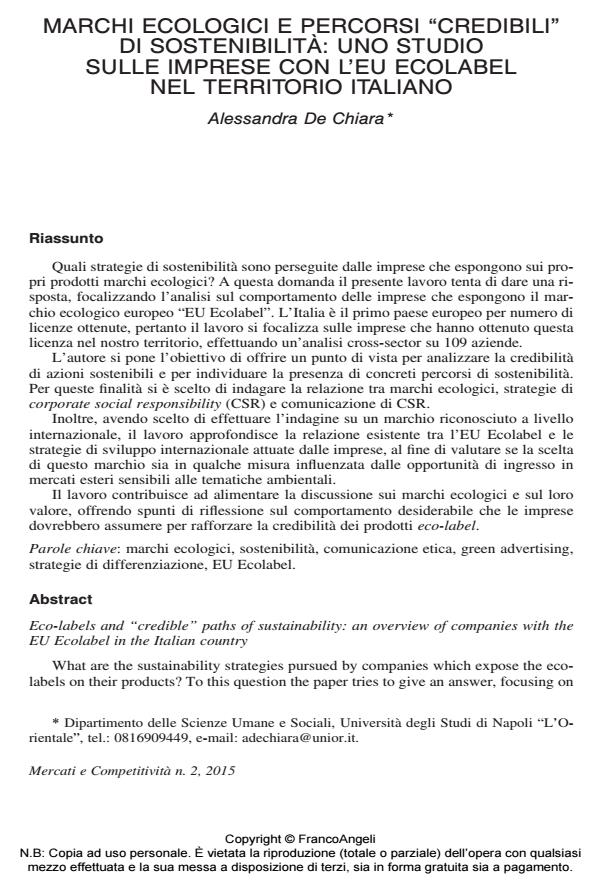Marchi ecologici e percorsi "credibili" di sostenibilità: uno studio sulle imprese con l’Eu Ecolabel nel territorio italiano
Titolo Rivista MERCATI & COMPETITIVITÀ
Autori/Curatori Alessandra De Chiara
Anno di pubblicazione 2015 Fascicolo 2015/2
Lingua Italiano Numero pagine 28 P. 111-138 Dimensione file 1102 KB
DOI 10.3280/MC2015-002007
Il DOI è il codice a barre della proprietà intellettuale: per saperne di più
clicca qui
Qui sotto puoi vedere in anteprima la prima pagina di questo articolo.
Se questo articolo ti interessa, lo puoi acquistare (e scaricare in formato pdf) seguendo le facili indicazioni per acquistare il download credit. Acquista Download Credits per scaricare questo Articolo in formato PDF

FrancoAngeli è membro della Publishers International Linking Association, Inc (PILA)associazione indipendente e non profit per facilitare (attraverso i servizi tecnologici implementati da CrossRef.org) l’accesso degli studiosi ai contenuti digitali nelle pubblicazioni professionali e scientifiche
Quali strategie di sostenibilità sono perseguite dalle imprese che espongono sui propri prodotti marchi ecologici? A questa domanda il presente lavoro tenta di dare una risposta, focalizzando l’analisi sul comportamento delle imprese che espongono il marchio ecologico europeo "EU Ecolabel". L’Italia è il primo paese europeo per numero di licenze ottenute, pertanto il lavoro si focalizza sulle imprese che hanno ottenuto questa licenza nel nostro territorio, effettuando un’analisi cross-sector su 109 aziende. L’autore si pone l’obiettivo di offrire un punto di vista per analizzare la credibilità di azioni sostenibili e per individuare la presenza di concreti percorsi di sostenibilità. Per queste finalità si è scelto di indagare la relazione tra marchi ecologici, strategie di corporate social responsibility (CSR) e comunicazione di CSR. Inoltre, avendo scelto di effettuare l’indagine su un marchio riconosciuto a livello internazionale, il lavoro approfondisce la relazione esistente tra l’EU Ecolabel e le strategie di sviluppo internazionale attuate dalle imprese, al fine di valutare se la scelta di questo marchio sia in qualche misura influenzata dalle opportunità di ingresso in mercati esteri sensibili alle tematiche ambientali. Il lavoro contribuisce ad alimentare la discussione sui marchi ecologici e sul loro valore, offrendo spunti di riflessione sul comportamento desiderabile che le imprese dovrebbero assumere per rafforzare la credibilità dei prodotti eco-label.
Parole chiave:Marchi ecologici, sostenibilità, comunicazione etica, green advertising, strategie di differenziazione, EU Ecolabel
Alessandra De Chiara, Marchi ecologici e percorsi "credibili" di sostenibilità: uno studio sulle imprese con l’Eu Ecolabel nel territorio italiano in "MERCATI & COMPETITIVITÀ" 2/2015, pp 111-138, DOI: 10.3280/MC2015-002007